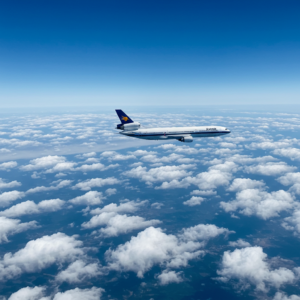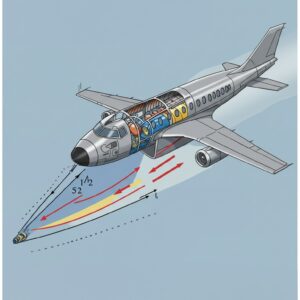
If you’ve ever looked at the flight tracker during a trip and noticed the aircraft cruising steadily at 35,000 feet, you’re not alone in wondering why that specific altitude is so common. It’s not just a nice round number or a legacy from aviation history. In fact, 35,000 feet represents a sweet spot that balances several technical and operational factors in commercial aviation.
The atmosphere around our planet is layered, and the one we live in—the troposphere—stretches up to about 36,000 feet. Most commercial jets operate right near the top of this layer, and sometimes a little into the lower stratosphere. Why? Because that part of the sky offers the most favorable conditions for long-range, high-efficiency travel.
At 35,000 feet, the air is much thinner than at sea level. That reduced air density means airplanes encounter less resistance as they move forward—what engineers call “drag.” With less drag, jet engines don’t need to work as hard to maintain speed, which translates into better fuel economy. For airlines, this is crucial. Jet fuel is one of the largest expenses for any airline, so being able to fly more miles on less fuel makes a big difference in both operating costs and environmental impact.
But there’s a tradeoff. As you go higher, while drag decreases, so does the amount of air available to feed the engines. Jet engines operate by sucking in air, compressing it, mixing it with fuel, and igniting it. The higher you go, the thinner the air, and that means less oxygen to support combustion. If you go too high, the engines won’t generate enough thrust. If you stay too low, you burn more fuel pushing through thicker air. The altitude around 35,000 feet has proven to be the best compromise: high enough to avoid heavy drag and bad weather, but not so high that engine performance is compromised.
Another factor that influences cruise altitude is weather. Most storm activity, turbulence, and cloud cover happen in the lower part of the troposphere. By flying above 30,000 feet, planes can avoid much of that instability. That’s why flights at cruising altitude tend to be smoother and less prone to delays due to weather systems. Even so, turbulence can still occur—especially in the form of clear-air turbulence near the jet stream—but it’s generally milder and more manageable at those heights.
Let’s not forget the role of aircraft design and passenger safety. At 35,000 feet, the outside air pressure is much lower than what humans need to breathe. That’s where cabin pressurization systems come in. These systems ensure the air inside the plane feels like you’re at an altitude of 6,000 to 8,000 feet, which is about the elevation of cities like Denver or Bogotá. It’s enough to breathe comfortably and safely, and the aircraft structure is designed to maintain that internal pressure despite the thin air outside.
Traffic management also plays a role in the selection of cruise altitudes. In controlled airspace, planes flying in the same direction are assigned altitudes in increments to keep them safely separated from one another. Eastbound flights typically cruise at odd-numbered altitudes like 35,000 or 37,000 feet, while westbound flights fly at even-numbered altitudes like 34,000 or 36,000 feet. This standardized system helps keep global air traffic moving smoothly and safely.
There are situations, of course, when a plane can’t cruise at 35,000 feet. For example, if an aircraft is especially heavy after takeoff—due to a full load of passengers, fuel, and cargo—it might only be able to reach 30,000 feet initially. As the flight progresses and the plane burns fuel, it becomes lighter. The pilot may then climb in increments to reach a more efficient altitude. This strategy is called a “step climb” and is commonly used on long-haul routes.

While commercial jets tend to favor 35,000 feet, private jets and military aircraft often cruise higher—sometimes above 40,000 feet. These aircraft are typically lighter and equipped with engines optimized for high-altitude performance. On the other hand, smaller propeller-driven planes without pressurization systems generally fly below 10,000 feet.
Historically, aircraft used to fly much lower. In the early decades of aviation, planes would stay under 10,000 feet because pressurization technology wasn’t available and engine performance declined too sharply at higher altitudes. The introduction of jet engines and pressurized cabins in the mid-20th century allowed planes to climb higher, and engineers eventually settled on the 30,000 to 40,000-foot range as ideal for jet-powered commercial aircraft. The 35,000-foot standard that dominates today is based on decades of operational data, engine design evolution, and real-world experience.
From a safety standpoint, cruising at high altitude gives pilots more options in an emergency. If an engine fails or a sudden pressurization issue occurs, the aircraft has enough altitude to glide for a long distance while the crew evaluates the situation. In fact, commercial aircraft are designed to safely descend from cruising altitude to 10,000 feet—where breathable air exists—in just minutes if cabin pressure is lost. This altitude buffer is a key part of aviation safety protocols.
It’s also worth noting that flying higher contributes to reduced aircraft noise for people on the ground. Jet engines at 35,000 feet sound like a distant hum, whereas older planes flying lower produced a roar that could disrupt neighborhoods near airports. Modern turbofan engines are also more efficient and quieter than the older turbojets, reducing environmental and noise pollution.
There’s an environmental dimension too. Higher cruising altitudes reduce overall fuel burn, which lowers carbon emissions per mile flown. However, scientists are studying how emissions released at high altitudes may affect the climate differently than those at ground level, due to the formation of contrails and potential impacts on high-altitude clouds. The aviation industry continues to explore ways to minimize these effects through more efficient engine designs, sustainable fuels, and alternative propulsion systems.
Ultimately, the reason we fly at 35,000 feet comes down to one idea: balance. It’s the altitude where commercial jets achieve optimal fuel efficiency, maintain engine performance, stay above turbulent weather, and retain a wide margin of safety for passengers and crew. This sweet spot has become the global norm not just by tradition, but by scientific analysis, engineering advancements, and practical experience.
In the future, things could change. New propulsion systems, like electric or hydrogen-powered engines, may have different optimal operating altitudes. Innovations in aircraft design might also allow for safer, quieter, and more efficient flight at different altitudes. But for now, when you hear the ding of the seatbelt sign turning off and glance at the in-flight screen showing 35,000 feet, you’ll know why that number is more than just a random figure. It’s a carefully calculated decision at the heart of every successful commercial flight.
